Introduction to Project ACRN¶
The open source project ACRN defines a device hypervisor reference stack and an architecture for running multiple software subsystems, managed securely, on a consolidated system by means of a virtual machine manager. It also defines a reference framework implementation for virtual device emulation, called the “ACRN Device Model”.
The ACRN Hypervisor is a Type 1 reference hypervisor stack, running directly on the bare-metal hardware, and is suitable for a variety of IoT and embedded device solutions. The ACRN hypervisor addresses the gap that currently exists between datacenter hypervisors, and hard partitioning hypervisors. The ACRN hypervisor architecture partitions the system into different functional domains, with carefully selected guest OS sharing optimizations for IoT and embedded devices.
Automotive Use Case Example¶
An interesting use case example for the ACRN Hypervisor is in an automotive scenario. The ACRN hypervisor can be used for building a Software Defined Cockpit (SDC) or an In-Vehicle Experience (IVE) solution. As a reference implementation, ACRN provides the basis for embedded hypervisor vendors to build solutions with a reference I/O mediation solution.
In this scenario, an automotive SDC system consists of the Instrument Cluster (IC) system, the In-Vehicle Infotainment (IVI) system, and one or more Rear Seat Entertainment (RSE) systems. Each system is running as an isolated Virtual Machine (VM) for overall system safety considerations.
An Instrument Cluster (IC) system is used to show the driver operational information about the vehicle, such as:
- the speed, the fuel level, trip mile and other driving information of the car;
- projecting heads-up images on the windshield, with alerts for low fuel or tire pressure;
- showing rear-view camera, and surround-view for parking assistance.
An In-Vehicle Infotainment (IVI) system’s capabilities can include:
- navigation systems, radios, and other entertainment systems;
- connection to mobile devices for phone calls, music, and applications via voice recognition;
- control interaction by gesture recognition or touch.
A Rear Seat Entertainment (RSE) system could run:
- entertainment system;
- virtual office;
- connection to the front-seat IVI system and mobile devices (cloud connectivity).
- connection to mobile devices for phone calls, music, and applications via voice recognition;
- control interaction by gesture recognition or touch
The ACRN hypervisor can support both Linux* VM and Android* VM as a User OS, with the User OS managed by the ACRN hypervisor. Developers and OEMs can use this reference stack to run their own VMs, together with IC, IVI, and RSE VMs. The Service OS runs as SOS_VM (also known as Dom0 in other hypervisors) and the User OS runs as POST_LAUNCHED_VM, (also known as DomU).
Figure 1 shows an example block diagram of using the ACRN hypervisor.
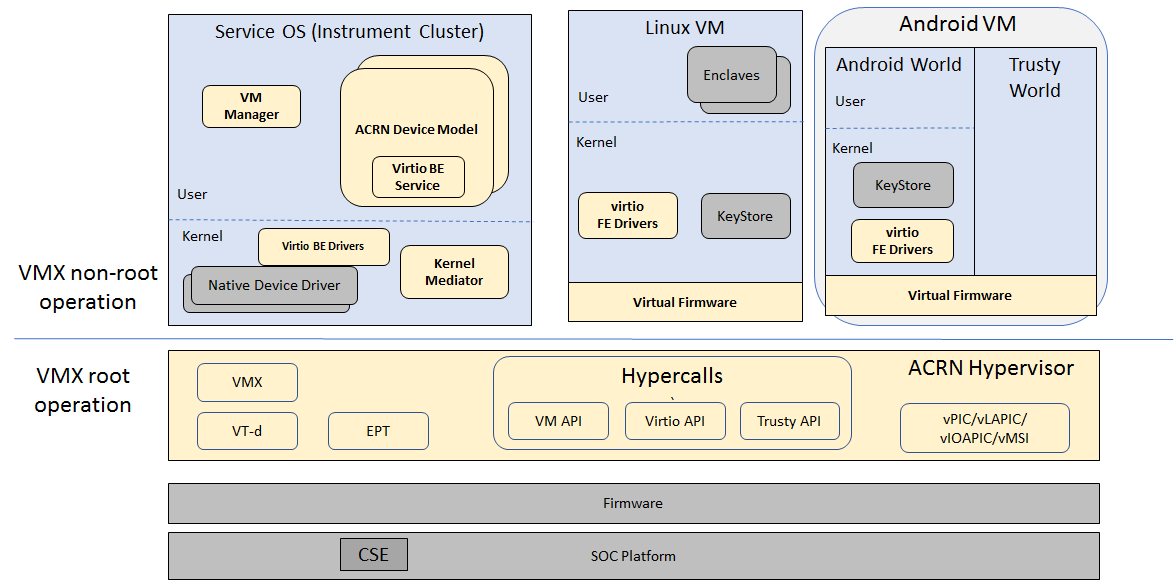
Figure 1 Service OS and User OS on top of ACRN hypervisor
This ACRN hypervisor block diagram shows:
- The ACRN hypervisor sits right on top of the bootloader for fast booting capabilities.
- Partitioning of resources to ensure safety-critical and non-safety critical domains are able to coexist on one platform.
- Rich I/O mediators allows various I/O devices shared across VMs, and thus delivers a comprehensive user experience
- Multiple operating systems are supported by one SoC through efficient virtualization.
Note
The yellow color parts in Figure 1 are part of the project ACRN software stack. This is a reference architecture diagram and not all features mentioned are fully functional. Other blocks will come from other (open source) projects and are listed here for reference only.
For example: the Service OS and Linux Guest can come from the Clear Linux project at https://clearlinux.org and (in later updates) the Android as a Guest support can come from https://01.org/projectceladon.
For the current ACRN-supported feature list, please see Release Notes.
Licensing¶
Both the ACRN hypervisor and ACRN Device model software are provided under the permissive BSD-3-Clause license, which allows “redistribution and use in source and binary forms, with or without modification” together with the intact copyright notice and disclaimers noted in the license.
ACRN Device Model, Service OS, and User OS¶
To keep the hypervisor code base as small and efficient as possible, the bulk of the device model implementation resides in the Service OS to provide sharing and other capabilities. The details of which devices are shared and the mechanism used for their sharing is described in pass-through section below.
The Service OS runs with the system’s highest virtual machine priority to ensure required device time-sensitive requirements and system quality of service (QoS). Service OS tasks run with mixed priority. Upon a callback servicing a particular User OS request, the corresponding software (or mediator) in the Service OS inherits the User OS priority. There may also be additional low-priority background tasks within the Service OS.
In the automotive example we described above, the User OS is the central hub of vehicle control and in-vehicle entertainment. It provides support for radio and entertainment options, control of the vehicle climate control, and vehicle navigation displays. It also provides connectivity options for using USB, Bluetooth, and Wi-Fi for third-party device interaction with the vehicle, such as Android Auto* or Apple CarPlay*, and many other features.
Boot Sequence¶
In Figure 2 we show a verified Boot Sequence with UEFI on an Intel Architecture platform NUC (see Supported Hardware).

Figure 2 ACRN Hypervisor Boot Flow¶
The Boot process proceeds as follows:
- UEFI verifies and boots the ACRN hypervisor and Service OS Bootloader
- UEFI (or Service OS Bootloader) verifies and boots Service OS kernel
- Service OS kernel verifies and loads ACRN Device Model and Virtual bootloader through dm-verity
- Virtual bootloader starts the User-side verified boot process
ACRN Hypervisor Architecture¶
ACRN hypervisor is a Type 1 hypervisor, running directly on bare-metal hardware. It implements a hybrid VMM architecture, using a privileged service VM, running the Service OS that manages the I/O devices and provides I/O mediation. Multiple User VMs are supported, with each of them running Linux* or Android* OS as the User OS .
Running systems in separate VMs provides isolation between other VMs and their applications, reducing potential attack surfaces and minimizing safety interference. However, running the systems in separate VMs may introduce additional latency for applications.
Figure 3 shows the ACRN hypervisor architecture, with the automotive example IC VM and service VM together. The Service OS (SOS) owns most of the devices including the platform devices, and provides I/O mediation. Some of the PCIe devices may be passed through to the User OSes via the VM configuration. The SOS runs the IC applications and hypervisor-specific applications together, such as the ACRN device model, and ACRN VM manager.
ACRN hypervisor also runs the ACRN VM manager to collect running information of the User OS, and controls the User VM such as starting, stopping, and pausing a VM, pausing or resuming a virtual CPU.

Figure 3 ACRN Hypervisor Architecture
ACRN hypervisor takes advantage of Intel Virtualization Technology (Intel VT), and ACRN hypervisor runs in Virtual Machine Extension (VMX) root operation, or host mode, or VMM mode. All the guests, including UOS and SOS, run in VMX non-root operation, or guest mode. (Hereafter, we use the terms VMM mode and Guest mode for simplicity).
The VMM mode has 4 protection rings, but runs the ACRN hypervisor in ring 0 privilege only, leaving rings 1-3 unused. The guest (including SOS & UOS), running in Guest mode, also has its own four protection rings (ring 0 to 3). The User kernel runs in ring 0 of guest mode, and user land applications run in ring 3 of User mode (ring 1 & 2 are usually not used by commercial OSes).
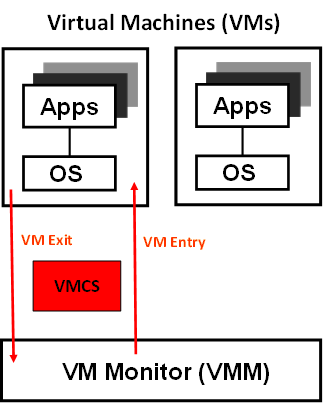
Figure 4 VMX Brief
As shown in Figure 4, VMM mode and guest mode are switched through VM Exit and VM Entry. When the bootloader hands off control to the ACRN hypervisor, the processor hasn’t enabled VMX operation yet. The ACRN hypervisor needs to enable VMX operation thru a VMXON instruction first. Initially, the processor stays in VMM mode when the VMX operation is enabled. It enters guest mode thru a VM resume instruction (or first time VM launch), and returns back to VMM mode thru a VM exit event. VM exit occurs in response to certain instructions and events.
The behavior of processor execution in guest mode is controlled by a virtual machine control structure (VMCS). VMCS contains the guest state (loaded at VM Entry, and saved at VM Exit), the host state, (loaded at the time of VM exit), and the guest execution controls. ACRN hypervisor creates a VMCS data structure for each virtual CPU, and uses the VMCS to configure the behavior of the processor running in guest mode.
When the execution of the guest hits a sensitive instruction, a VM exit event may happen as defined in the VMCS configuration. Control goes back to the ACRN hypervisor when the VM exit happens. The ACRN hypervisor emulates the guest instruction (if the exit was due to privilege issue) and resumes the guest to its next instruction, or fixes the VM exit reason (for example if a guest memory page is not mapped yet) and resume the guest to re-execute the instruction.
Note that the address space used in VMM mode is different from that in guest mode. The guest mode and VMM mode use different memory mapping tables, and therefore the ACRN hypervisor is protected from guest access. The ACRN hypervisor uses EPT to map the guest address, using the guest page table to map from guest linear address to guest physical address, and using the EPT table to map from guest physical address to machine physical address or host physical address (HPA).
ACRN Device Model Architecture¶
Because devices may need to be shared between VMs, device emulation is used to give VM applications (and OSes) access to these shared devices. Traditionally there are three architectural approaches to device emulation:
- The first architecture is device emulation within the hypervisor which is a common method implemented within the VMware* workstation product (an operating system-based hypervisor). In this method, the hypervisor includes emulations of common devices that the various guest operating systems can share, including virtual disks, virtual network adapters, and other necessary platform elements.
- The second architecture is called user space device emulation. As the name implies, rather than the device emulation being embedded within the hypervisor, it is instead implemented in a separate user space application. QEMU, for example, provides this kind of device emulation also used by a large number of independent hypervisors. This model is advantageous, because the device emulation is independent of the hypervisor and can therefore be shared for other hypervisors. It also permits arbitrary device emulation without having to burden the hypervisor (which operates in a privileged state) with this functionality.
- The third variation on hypervisor-based device emulation is paravirtualized (PV) drivers. In this model introduced by the XEN project the hypervisor includes the physical drivers, and each guest operating system includes a hypervisor-aware driver that works in concert with the hypervisor drivers.
In the device emulation models discussed above, there’s a price to pay for sharing devices. Whether device emulation is performed in the hypervisor, or in user space within an independent VM, overhead exists. This overhead is worthwhile as long as the devices need to be shared by multiple guest operating systems. If sharing is not necessary, then there are more efficient methods for accessing devices, for example “pass-through”.
ACRN device model is a placeholder of the UOS. It allocates memory for the User OS, configures and initializes the devices used by the UOS, loads the virtual firmware, initializes the virtual CPU state, and invokes the ACRN hypervisor service to execute the guest instructions. ACRN Device model is an application running in the Service OS that emulates devices based on command line configuration, as shown in the architecture diagram Figure 5 below:
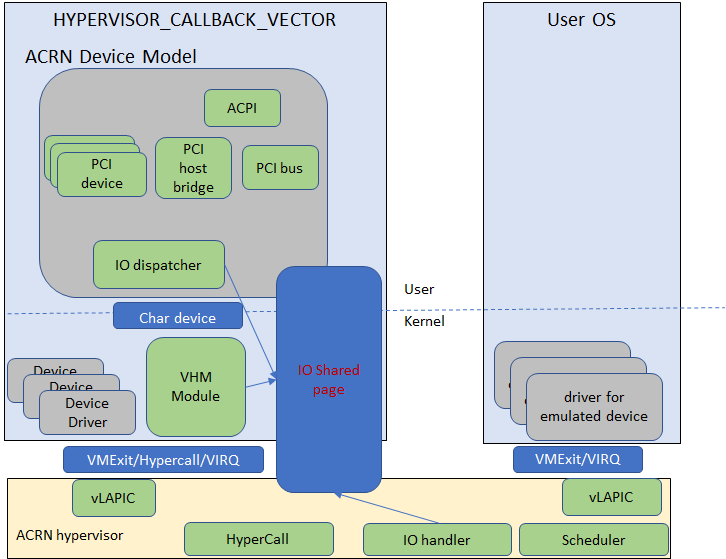
Figure 5 ACRN Device Model
ACRN Device model incorporates these three aspects:
- Device Emulation:
- ACRN Device model provides device emulation routines that register their I/O handlers to the I/O dispatcher. When there is an I/O request from the User OS device, the I/O dispatcher sends this request to the corresponding device emulation routine.
- I/O Path:
- see ACRN-io-mediator below
- VHM:
The Virtio and Hypervisor Service Module is a kernel module in the Service OS acting as a middle layer to support the device model. The VHM and its client handling flow is described below:
- ACRN hypervisor IOREQ is forwarded to the VHM by an upcall notification to the SOS.
- VHM will mark the IOREQ as “in process” so that the same IOREQ will not pick up again. The IOREQ will be sent to the client for handling. Meanwhile, the VHM is ready for another IOREQ.
- IOREQ clients are either an SOS Userland application or a Service OS Kernel space module. Once the IOREQ is processed and completed, the Client will issue an IOCTL call to the VHM to notify an IOREQ state change. The VHM then checks and hypercalls to ACRN hypervisor notifying it that the IOREQ has completed.
Note
Userland: dm as ACRN Device Model.
Kernel space: VBS-K, MPT Service, VHM itself
Device pass through¶
At the highest level, device pass-through is about providing isolation of a device to a given guest operating system so that the device can be used exclusively by that guest.
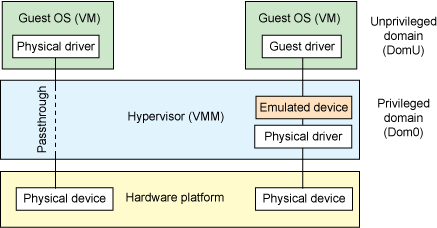
Figure 6 Device Passthrough
Near-native performance can be achieved by using device passthrough. This is ideal for networking applications (or those with high disk I/O needs) that have not adopted virtualization because of contention and performance degradation through the hypervisor (using a driver in the hypervisor or through the hypervisor to a user space emulation). Assigning devices to specific guests is also useful when those devices inherently wouldn’t be shared. For example, if a system includes multiple video adapters, those adapters could be passed through to unique guest domains.
Finally, there may be specialized PCI devices that only one guest domain uses, so they should be passed through to the guest. Individual USB ports could be isolated to a given domain too, or a serial port (which is itself not shareable) could be isolated to a particular guest. In ACRN hypervisor, we support USB controller Pass through only and we don’t support pass through for a legacy serial port, (for example 0x3f8).
Hardware support for device passthrough¶
Intel’s current processor architectures provides support for device pass-through with VT-d. VT-d maps guest physical address to machine physical address, so device can use guest physical address directly. When this mapping occurs, the hardware takes care of access (and protection), and the guest operating system can use the device as if it were a non-virtualized system. In addition to mapping guest to physical memory, isolation prevents this device from accessing memory belonging to other guests or the hypervisor.
Another innovation that helps interrupts scale to large numbers of VMs is called Message Signaled Interrupts (MSI). Rather than relying on physical interrupt pins to be associated with a guest, MSI transforms interrupts into messages that are more easily virtualized (scaling to thousands of individual interrupts). MSI has been available since PCI version 2.2 but is also available in PCI Express (PCIe), where it allows fabrics to scale to many devices. MSI is ideal for I/O virtualization, as it allows isolation of interrupt sources (as opposed to physical pins that must be multiplexed or routed through software).
Hypervisor support for device passthrough¶
By using the latest virtualization-enhanced processor architectures, hypervisors and virtualization solutions can support device pass-through (using VT-d), including Xen, KVM, and ACRN hypervisor. In most cases, the guest operating system (User OS) must be compiled to support pass-through, by using kernel build-time options. Hiding the devices from the host VM may also be required (as is done with Xen using pciback). Some restrictions apply in PCI, for example, PCI devices behind a PCIe-to-PCI bridge must be assigned to the same guest OS. PCIe does not have this restriction.
ACRN I/O mediator¶
Figure 7 shows the flow of an example I/O emulation path.
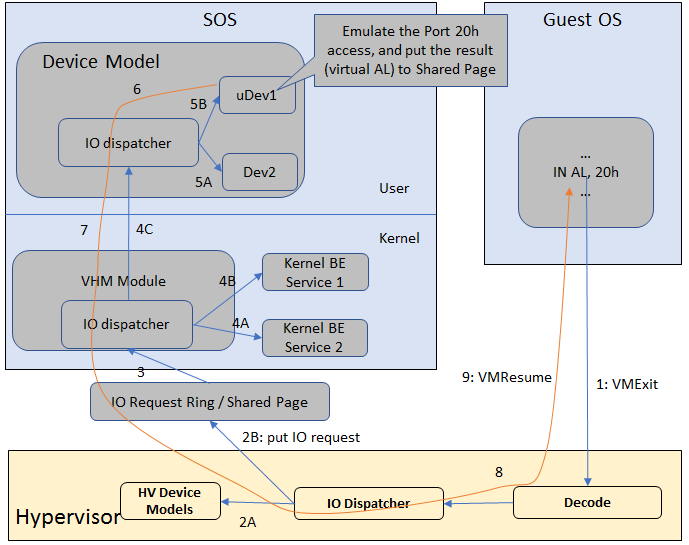
Figure 7 I/O Emulation Path
Following along with the numbered items in Figure 7:
- When a guest execute an I/O instruction (PIO or MMIO), a VM exit happens. ACRN hypervisor takes control, and analyzes the the VM exit reason, which is a VMX_EXIT_REASON_IO_INSTRUCTION for PIO access.
- ACRN hypervisor fetches and analyzes the guest instruction, and
notices it is a PIO instruction (
in AL, 20hin this example), and put the decoded information (including the PIO address, size of access, read/write, and target register) into the shared page, and notify/interrupt the SOS to process. - The Virtio and hypervisor service module (VHM) in SOS receives the interrupt, and queries the IO request ring to get the PIO instruction details.
- It checks to see if any kernel device claims ownership of the IO port: if a kernel module claimed it, the kernel module is activated to execute its processing APIs. Otherwise, the VHM module leaves the IO request in the shared page and wakes up the device model thread to process.
- The ACRN device model follow the same mechanism as the VHM. The I/O processing thread of device model queries the IO request ring to get the PIO instruction details and checks to see if any (guest) device emulation module claims ownership of the IO port: if a module claimed it, the module is invoked to execute its processing APIs.
- After the ACRN device module completes the emulation (port IO 20h access in this example), (say uDev1 here), uDev1 puts the result into the shared page (in register AL in this example).
- ACRN device model then returns control to ACRN hypervisor to indicate the completion of an IO instruction emulation, typically thru VHM/hypercall.
- The ACRN hypervisor then knows IO emulation is complete, and copies the result to the guest register context.
- The ACRN hypervisor finally advances the guest IP to indicate completion of instruction execution, and resumes the guest.
The MMIO path is very similar, except the VM exit reason is different. MMIO access usually is trapped thru VMX_EXIT_REASON_EPT_VIOLATION in the hypervisor.
Virtio framework architecture¶
Virtio is an abstraction for a set of common emulated devices in any type of hypervisor. In the ACRN reference stack, our implementation is compatible with Virtio spec 0.9 and 1.0. By following this spec, virtual environments and guests should have a straightforward, efficient, standard and extensible mechanism for virtual devices, rather than boutique per-environment or per-OS mechanisms.
Virtio provides a common frontend driver framework which not only standardizes device interfaces, but also increases code reuse across different virtualization platforms.
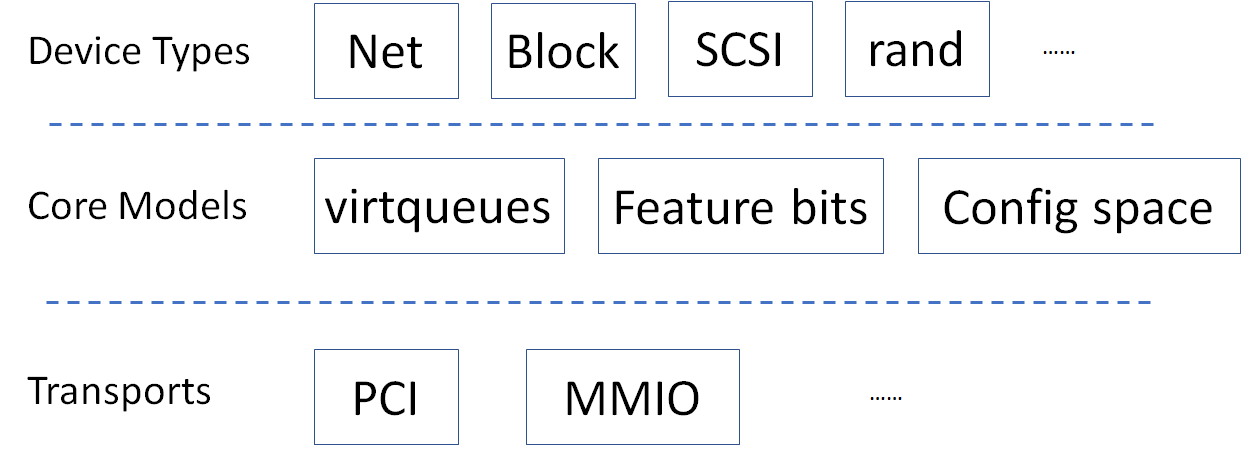
Figure 8 Virtio Architecture
To better understand Virtio, especially its usage in the ACRN project, several key concepts of Virtio are highlighted here:
- Front-End Virtio driver (a.k.a. frontend driver, or FE driver in this document)
- Virtio adopts a frontend-backend architecture, which enables a simple but flexible framework for both frontend and backend Virtio driver. The FE driver provides APIs to configure the interface, pass messages, produce requests, and notify backend Virtio driver. As a result, the FE driver is easy to implement and the performance overhead of emulating device is eliminated.
- Back-End Virtio driver (a.k.a. backend driver, or BE driver in this document)
- Similar to FE driver, the BE driver, runs either in user-land or kernel-land of host OS. The BE driver consumes requests from FE driver and send them to the host’s native device driver. Once the requests are done by the host native device driver, the BE driver notifies the FE driver about the completeness of the requests.
- Straightforward: Virtio devices as standard devices on existing Buses
- Instead of creating new device buses from scratch, Virtio devices are built on existing buses. This gives a straightforward way for both FE and BE drivers to interact with each other. For example, FE driver could read/write registers of the device, and the virtual device could interrupt FE driver, on behalf of the BE driver, in case of something is happening. Currently Virtio supports PCI/PCIe bus and MMIO bus. In ACRN project, only PCI/PCIe bus is supported, and all the Virtio devices share the same vendor ID 0x1AF4.
- Efficient: batching operation is encouraged
- Batching operation and deferred notification are important to achieve high-performance I/O, since notification between FE and BE driver usually involves an expensive exit of the guest. Therefore batching operating and notification suppression are highly encouraged if possible. This will give an efficient implementation for the performance critical devices.
- Standard: virtqueue
All the Virtio devices share a standard ring buffer and descriptor mechanism, called a virtqueue, shown in Figure 6. A virtqueue is a queue of scatter-gather buffers. There are three important methods on virtqueues:
add_bufis for adding a request/response buffer in a virtqueueget_bufis for getting a response/request in a virtqueue, andkickis for notifying the other side for a virtqueue to consume buffers.
The virtqueues are created in guest physical memory by the FE drivers. The BE drivers only need to parse the virtqueue structures to obtain the requests and get the requests done. How virtqueue is organized is specific to the User OS. In the implementation of Virtio in Linux, the virtqueue is implemented as a ring buffer structure called vring.
In ACRN, the virtqueue APIs can be leveraged directly so users don’t need to worry about the details of the virtqueue. Refer to the User OS for more details about the virtqueue implementations.
- Extensible: feature bits
- A simple extensible feature negotiation mechanism exists for each virtual device and its driver. Each virtual device could claim its device specific features while the corresponding driver could respond to the device with the subset of features the driver understands. The feature mechanism enables forward and backward compatibility for the virtual device and driver.
In the ACRN reference stack, we implement user-land and kernel space as shown in Figure 9:
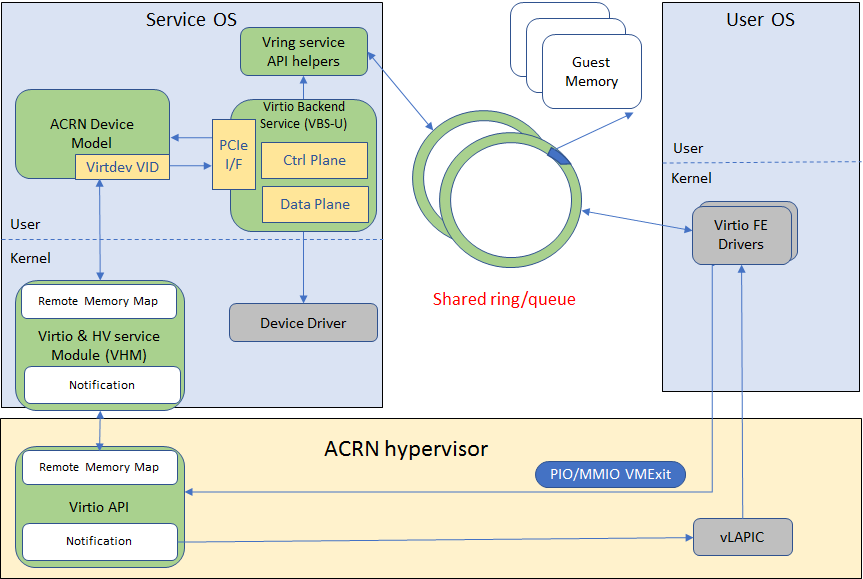
Figure 9 Virtio Framework - User Land
In the Virtio user-land framework, the implementation is compatible with Virtio Spec 0.9/1.0. The VBS-U is statically linked with Device Model, and communicates with Device Model through the PCIe interface: PIO/MMIO or MSI/MSIx. VBS-U accesses Virtio APIs through user space vring service API helpers. User space vring service API helpers access shared ring through remote memory map (mmap). VHM maps UOS memory with the help of ACRN Hypervisor.
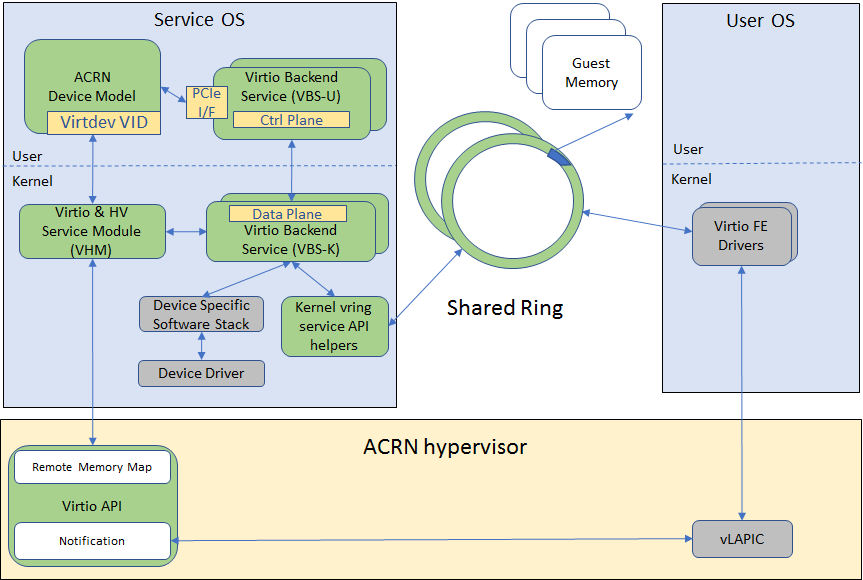
Figure 10 Virtio Framework - Kernel Space
VBS-U offloads data plane processing to VBS-K. VBS-U initializes VBS-K at the right timings, for example. The FE driver sets VIRTIO_CONFIG_S_DRIVER_OK to avoid unnecessary device configuration changes while running. VBS-K can access shared rings through VBS-K virtqueue APIs. VBS-K virtqueue APIs are similar to VBS-U virtqueue APIs. VBS-K registers as VHM client(s) to handle a continuous range of registers
There may be one or more VHM-clients for each VBS-K, and there can be a single VHM-client for all VBS-Ks as well. VBS-K notifies FE through VHM interrupt APIs.